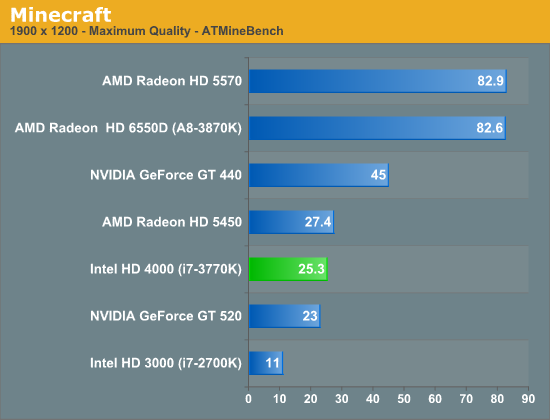The Intel Ivy Bridge (Core i7 3770K) Review
by Anand Lal Shimpi & Ryan Smith on April 23, 2012 12:03 PM EST- Posted in
- CPUs
- Intel
- Ivy Bridge
Switching gears for the moment we have Minecraft, our OpenGL title. It's no secret that OpenGL usage on the PC has fallen by the wayside in recent years, and as far major games go Minecraft is one of but a few recently released major titles using OpenGL. Minecraft is incredibly simple—not even utilizing pixel shaders let alone more advanced hardware—but this doesn't mean it's easy to render. Its use of massive amounts of blocks (and the overdraw that creates) means you need solid hardware and an efficient OpenGL implementation if you want to hit playable framerates with a far render distance. Consequently, as the most successful OpenGL game in quite some number of years (at over 5.5mil copies sold), it's a good reminder for GPU manufacturers that OpenGL is not to be ignored.

Our test here is pretty simple: we're looking at lush forest after the world finishes loading. In spite of a lack of any kind of shader workload for Ivy Bridge, it's still struggling here. On the one hand this is the single biggest gain over Sandy Bridge we've seen in any of our tests, with Ivy Bridge improving on its predecessor by an incredible 130%, and at the same time it's still only competitive with the entry-level discrete GPUs. Worse, for all of its gains, Ivy Bridge is still only achieving a mere 30% of the performance of Llano here.
Since this is largely a pixel pushing test, we'd expect Llano and Ivy Bridge to be closer than where they are. Given the gains versus Sandy Bridge Intel may still have some ROP bottlenecks that only come out in unusual workloads like Minecraft, but at the same time it's hard to imagine that OpenGL drivers aren't playing a role here. If that's the case, then Intel clearly has some work to do.










173 Comments
View All Comments
Tujan - Tuesday, April 24, 2012 - link
cause how I see it :" If you're constantly transcoding movies to get them onto your smartphone or tablet, you need Ivy Bridge. In less than 7 minutes, and with no impact to CPU usage, I was able to transcode a complete 130 minute 1080p video to an iPad friendly format—that's over 15x real time."
The majority of trancoding is going the other way- from an ipad friendly format to another friendly type format (device or not). Cell phone to pc,ipad to youtube etc.
I like the concept of the transcode,encode,but as much as with the bandwidth necesary to utilize them they are as they are 'bandwidth hungry'. And here is the first I have noticed that of telling there is hardware to facilitate the h.264 type encoding. "Hardware" to do this.
The screens from all of those cell phones in high resolution 'still'require bandwidth to utilize them. .. and so on.
I dont understand it completely but I'll attempt to stay tuned.
androticus - Tuesday, April 24, 2012 - link
I find this review enormously confusing. You mix IB and SB parts/sku's throughout, without clearly highlighting which is which. On page 2, at first I thought the chart was of IB CPUs, but then realized it was a mishmash of both. Likewise on all the benchmark charts, and I couldn't even distinguish various SB/IB/core counts apart.Was this article written solely for people who have a PhD in Intel sku's ???
Dudenell - Tuesday, April 24, 2012 - link
Could we actually see comparison with the i7-920 or i7-950 in there?Pjotr - Wednesday, April 25, 2012 - link
Thanks for the Compile test, this is all I look at to decide purchases at work.sld - Wednesday, April 25, 2012 - link
The A8 is conspicuously missing from the 2 charts showing idle and load system consumption. Why is this so?greggm2000 - Wednesday, April 25, 2012 - link
Anand/Ryan,According to the article linked below from today, it seems that Intel may be using TIM paste instead of fluxless solder in the IB chips, and if so, does this seem like a reasonable explanation for the high temperatures that people are seeing?
I'm interested in your thoughts on this... and if it's true, and if the article is correct, then Intel deliberately handicapping their chips (to possibly preserve SB-E sales?) is quite troubling to me.
http://www.overclockers.com/ivy-bridge-temperature...
slickr - Thursday, April 26, 2012 - link
Hi, is this good enough of an upgrade over a Pentium 4 for office, internet and movies?And will the HD4000 beat a ATI x1650XT?
Death666Angel - Friday, April 27, 2012 - link
Hey guys!Good review overall, thanks for that!
But the Quicksync section was kinda strange. No way that an x86 software solution generates worse IQ than any accelerated stuff. Unless you were comparing IQ with settings that have the x86 do recode the file in the same time it takes the other solutions. Anyway, I don't understand what you did in that section. :-)
kevith - Friday, April 27, 2012 - link
Great review.Would it be interesting to see how it fared in a series 6 motherboard, now that it actually is backwards compatible?
pwnsweet - Saturday, April 28, 2012 - link
The only thing I care about is how much faster this new slab of silicon will power though my x264 encoding and that's the one part of the review that was left out!Why anand, why!?